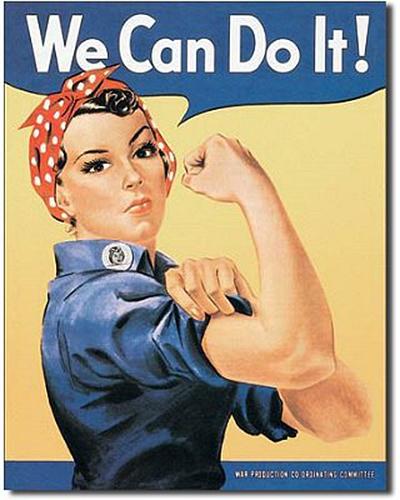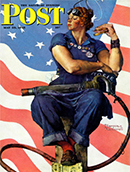Rosie the Riveter We Can Do It Retro Vintage Tin Sign
Product Features
- professional quality metal / tin sign
- tin signs are new and may have a vintage or distressed appearance
- enameled paint is attractive and very durable
- measures 12.25 by 16.00 inches
- ships quickly and safely in a protective envelope

The iconic poster that took forty years to become so...
Contrary to popular belief, the "We Can Do It!" poster was seen very little during World War II. Ask anyone who was around in America during the war and they will, if they're honest, shake their head and say that they do not remember seeing it at all. That's because chances are they never did see it. And that's what makes this poster so fascinating.
It was produced in 1942 by J Howard Miller for Westinghouse Electric as an inspirational image to boost worker morale and was displayed for two short weeks in February of 1943 to factory workers in East Pittsburgh, Pennsylvania, and the Midwest. It was just another of a series of 42 motivational and instructional posters designed by Miller through the services of an ad agency. The Office of War Information launched a massive nationwide advertising campaign to sell the war, but this "We Can Do It!" poster was simply not a part of it.
No more than 1,800 copies of the 17 x 22-inch poster were printed back then. It is generally thought to be based on a black-and-white wire service photograph taken of a Michigan factory worker named Geraldine Hoff.
The poster subsequently disappeared for nearly four decades until it was rediscovered in the early 1980s and widely reproduced in many forms, mainly due to it's copyright having slipped into the public domain. Only then was it ever called "Rosie the Riveter" and only then did it become an iconic a symbol of World War II.
Norman Rockwell's emblematic Rosie the Riveter painting was loaned by the magazine Saturday Evening Post to the US Treasury Department for use in posters and campaigns promoting war bonds. Following the war, the Rockwell painting gradually sank from public memory because it was copyrighted; all of Rockwell's paintings were vigorously defended by his estate after his death. This protection resulted in the original painting gaining value - it sold for nearly $5 million in 2002. Conversely, the lack of protection for the "We Can Do It!" image is one of the reasons it experienced such a massive rebirth.
As the popularity of this poster quickly spread, it also became a powerful symbol of female empowerment and has been reworked by numerous artists over the years to depict politicians and various political issues, and has been parodied for many an advertisement.
Ed Reis, a volunteer historian for Westinghouse, noted that the original image was not shown to female riveters during the war, so the recent association with "Rosie the Riveter" was unjustified. Rather, it was targeted at women who were making helmet liners out of Micarta. Reis joked that the woman in the image was more likely to have been named "Molly the Micarta Molder" or "Helen the Helmet Liner Maker."
From an historical standpoint, this poster was not an iconic symbol of WWII, but it certainly came to be so on a grand scale; as much as the photos of the flag raising on Iwo Jima or the V-E Day Times Square kiss or the British "Keep Calm" poster.
Related Scanning WWII links...
Related WWII Store items...
- We Can Do It!
1943 J Howard Miller Poster Print - We Can Do It!
Retro Vintage Tin Sign - We Can Do It!
Window Laptop Vinyl Decal Sticker - Rosie the Riveter:
Women Working on the Home Front in World War II - Design for Victory:
World War II Posters on the American Home Front - Making War, Making Women:
Femininity and Duty on the American Home Front, 1941-1945 - World War II for Kids:
A History with 21 Activities
![]()




